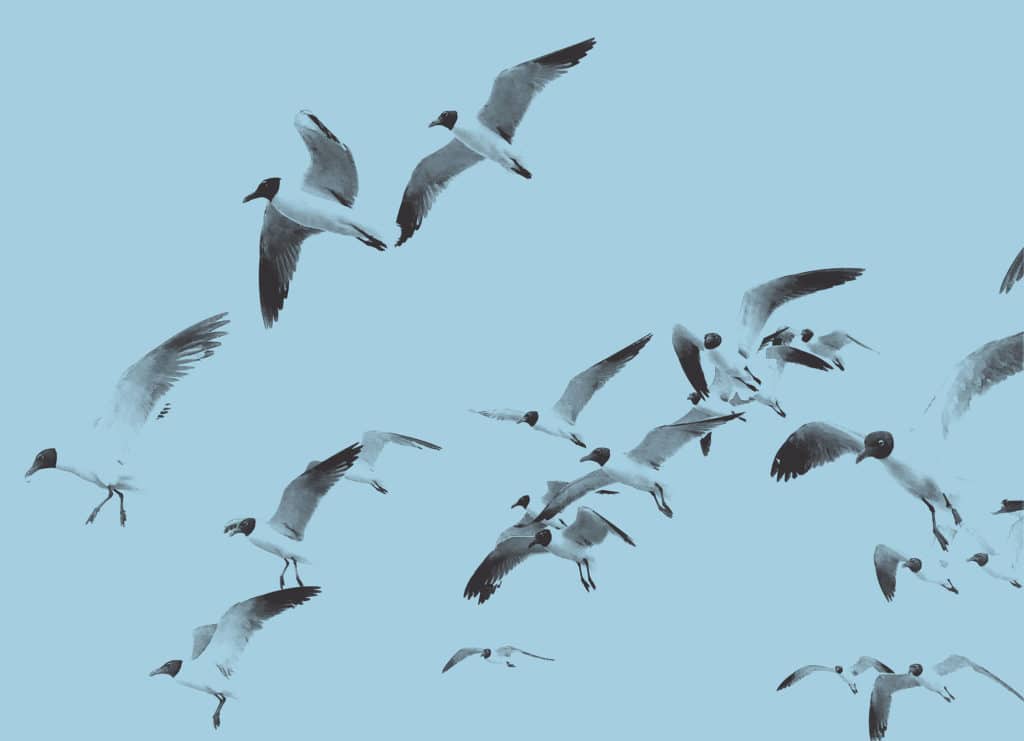
Along the Gulf coasts of Texas and Louisiana, when big flocks of sea gulls hold over shrimp and shad pushed to the surface by schools of hungry speckled trout and redfish, the fishing is going to be off the charts. And seasoned anglers look to the sky for telltale signs leading to exciting dawn-to-dusk action.
It all starts with the migration of shrimp and shad from the backwater marshes and estuary lakes that feed into the bays. That’s usually the result of falling water temperatures associated with the first mild cold fronts in late summer and early fall. The migration moves to the bays, and eventually into the Gulf of Mexico, with fantastic fishing often lasting well into November, or until the first hard cold front of the season moves through.
“When we start seeing the first flights of teal moving along the coast toward their wintering areas in Mexico, gulls are going to be holding over trout, and reds gorging on shrimp and shad,” says Capt. Jerry Norris, a longtime guide in Sabine Lake, on the Texas-Louisiana border. “The dove season opens on September 1, and the early teal season opens right after that, coinciding with the time when speckled trout and redfish become easier to find and catch.”
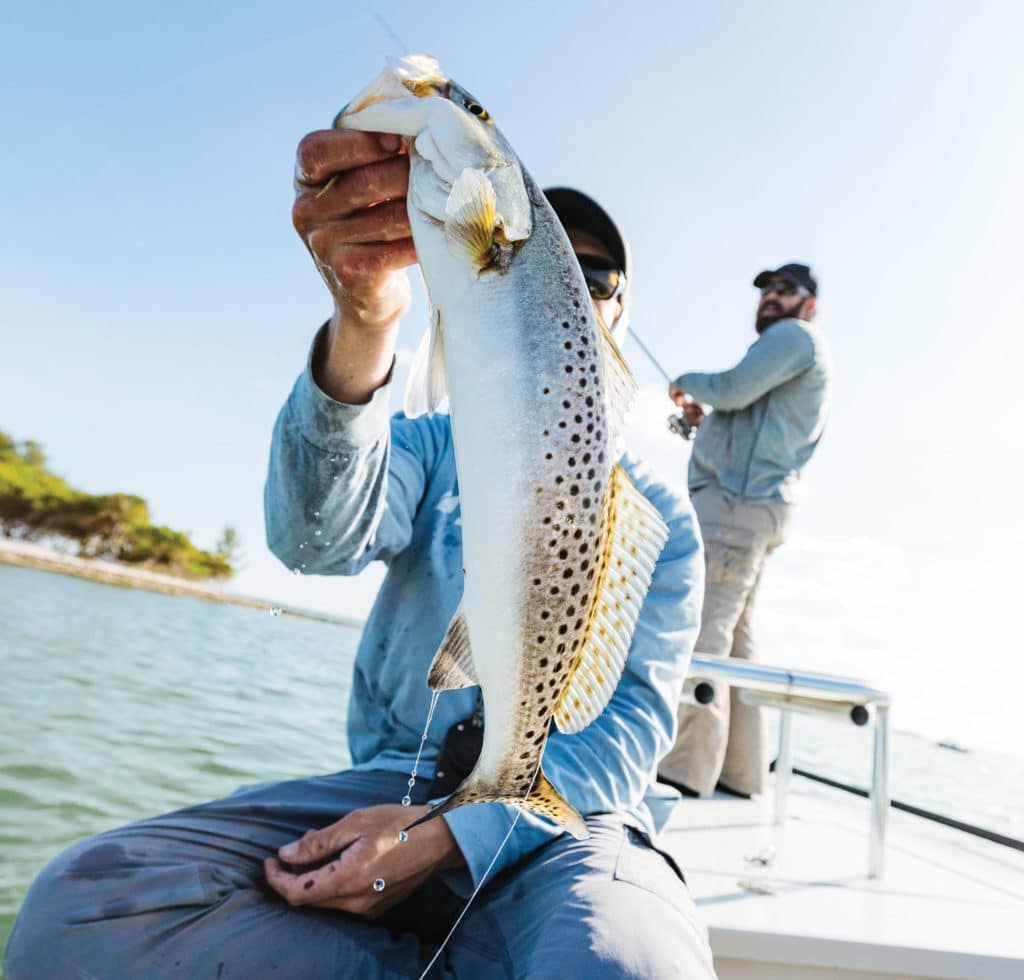
There are several bays where flocks of gulls tend to hover over hungry trout and reds. The No. 1 spot in Louisiana is Calcasieu Lake. The best places in Texas are Sabine Lake, East Galveston Bay, West Galveston Bay and East Matagorda Bay. All are easily accessible, with good boat ramps.
Typically, when the action under the birds begins, it’s with 13- to 15-inch male trout. But as the water temperature cools with passing fronts, trout in the 2- to 4-pound range move in. “During the first couple of weeks in September, we’ll be fishing with soft plastics rigged on ¼-ounce jig heads. The lures imitate shrimp that fish are feeding on,” says Capt. Jim West, who has been guiding on the Galveston Bay system for decades. “We not only have reds and speckled trout under the gulls, but also huge numbers of big sand trout,” he adds.
It’s easy to tap into the action. It only requires launching your boat and locating feeding flocks of sea gulls. The tool to keep you on the fish is a good pair of binoculars to spot gulls dipping and diving. In most situations, the first one or two boats to arrive will catch a few solid fish. Once more boats move in, the fish spook, and it’s time to find another flock of birds.
“The best way to approach a school of feeding trout is to shut down the outboard about 50 yards from the birds,” Norris says. “From there, ease to within casting distance with the trolling motor. Determining which way the fish are moving is very important, and being quiet is key. Once I get into the action, I try to position the boat so that it drifts with the current or wind alongside the feeding fish. When it’s done right, everybody in the boat hooks up. It’s fun fishing.”
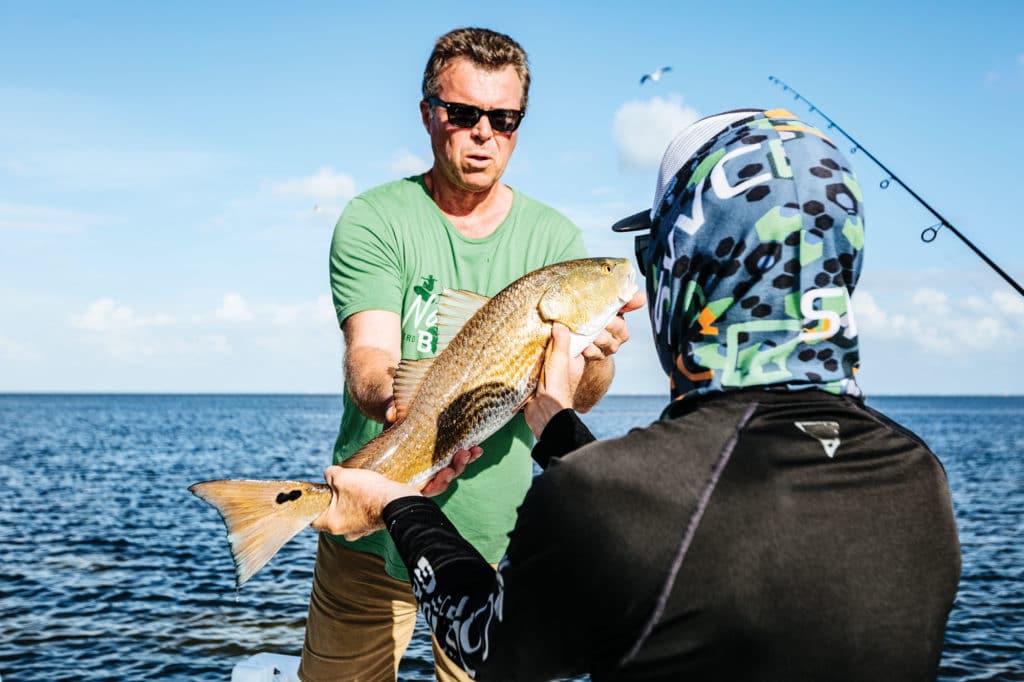
Hanging Around Pays Something else to keep in mind is that the fish won’t leave a good supply of shrimp or shad when disturbed, but rather will go to the bottom, away from the surface noise. After other boats leave to find another flock of gulls, anglers in the know stick around the area and work jigs along the bottom, a game plan that frequently produces 4- to 6-pound trout and, frequently, redfish in the 20- to 28-inch class.
Lures of Choice Soft-plastic jigs are the top overall lures for taking both trout and reds under birds. Silver spoons, topwater plugs and crankbaits are also good. A topwater often delivers the heavier fish. Such a lure can be cast well ahead of the boat, and that’s normally where the big, wary big trout feed near the surface.
“I’ve always got a topwater lure tied on, ready to fish,” says Matagorda guide Charlie Paradoski. “It’s definitely the best option for catching bigger trout and reds under the birds. A Super Spook works well; so does a MirrOlure She Dog. The color is really not that important, but some of my favorites are bone, pink-and-silver, and chrome-and-blue.
“Some of our best catches of big trout take place in late October and into November, and that’s the best time to use a topwater plug. If the water surface is slick-calm, scale down to something like a Super Spook Jr. If it’s a little rough, go with a larger plug like a MirrOlure Top Dog.”
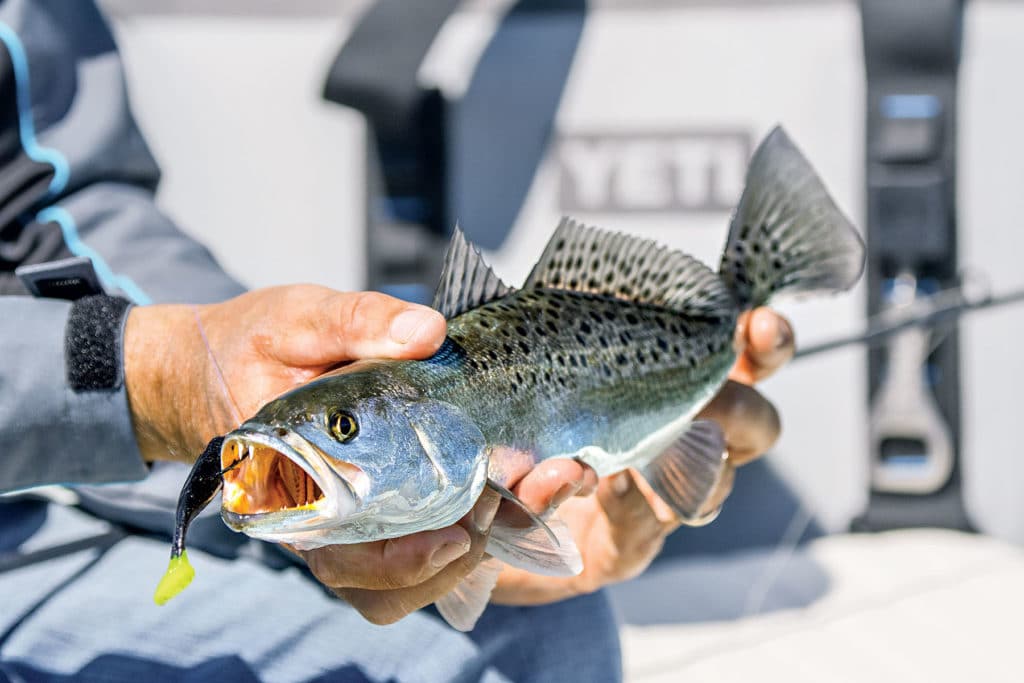
Good imitations of shad and pogies migrating from the marsh to the Gulf, silver spoons are effective on their own. But a ½-ounce silver spoon trailing a D.O.A. paddle-tail grub is deadly. The flash of the spoon combined with a grub in pearl or chartreuse will catch the larger fish, especially when the lure tandem is allowed to sink toward bottom. It’s a true redfish magnet, plus it can be cast out of sight, which is particularly important when you run into a school of reds. Of course, you have the option of fishing a spoon without a trailer. But if you take the treble hook off and add a single, straight-shank 2/0 hook and trailer to the spoon, you’ll more than likely catch heavier fish.
On Sabine Lake, it’s not at all unusual to see reds gorging on shad. Most are in the 25- to 30-inch class, and they make something akin to a boat wake when chasing a school of baitfish on top. Once a school is spotted, you either crank up the outboard and run to them, or determine the direction of the fish and cut them off. Redfish will hit just about anything they see, but the spoon with a trailer is especially good.
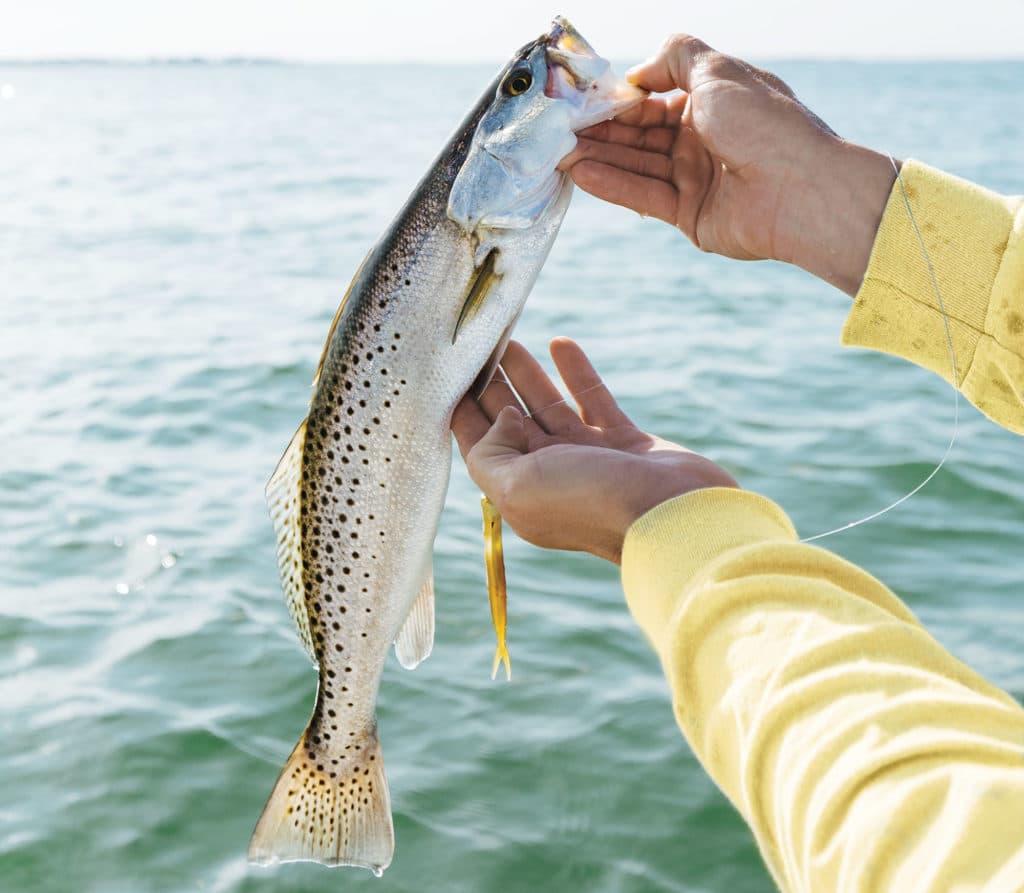
Try the Shrimp Most of the trout will be feeding on shrimp, so be sure to carry a supply of lures that imitate the crustaceans. It’s not unusual to see a big shrimp skipping across the surface, fleeing for it’s life. One of the most productive soft plastics is the original 4-inch D.O.A. shrimp. It comes pre-rigged and weighs ½ ounce. It’s easy to cast, and both trout and reds will eat them all day long. The 6-inch D.O.A. jumbo shrimp, which weighs 1¼ ounces, is another great choice. It can be cast a long way and resembles some of the big shrimp migrating to the Gulf. Some of the best colors are chartreuse with silver glitter, glow with a gold-rust belly, moss green with a red tail, pink-and-glow, and purple with a chartreuse tail
Read Next: Find Birds with Radar
Late August and September is when the action under the birds begins. Toward the middle of September, it starts to pick up. And come October, it’s not unusual to see huge flocks of gulls picking baitfish and shrimp off the surface. By the end of October and the first week of November, the action begins to wane. But that’s also when some of the heaviest trout start to show up under the birds. As the migration of shad and shrimp begins to peter out, you will no longer see the big flocks of gulls. Then, you might see only a half-dozen birds over a school of trout. But even if you spot just a single gull hovering over one particular area, go to it. You just never know. It could be suspending over a pair of reds, or an entire school.
Gulls aren’t the only birds that lead you to fish; terns and pelicans will also. Terns, aka liar birds, are much smaller than gulls and quite often appear to be over fish when they’re really not. Conversely, if you see pelicans diving into the water, definitely do not pass them up. Even a single pelican crashing into bait will more than likely be over trout.
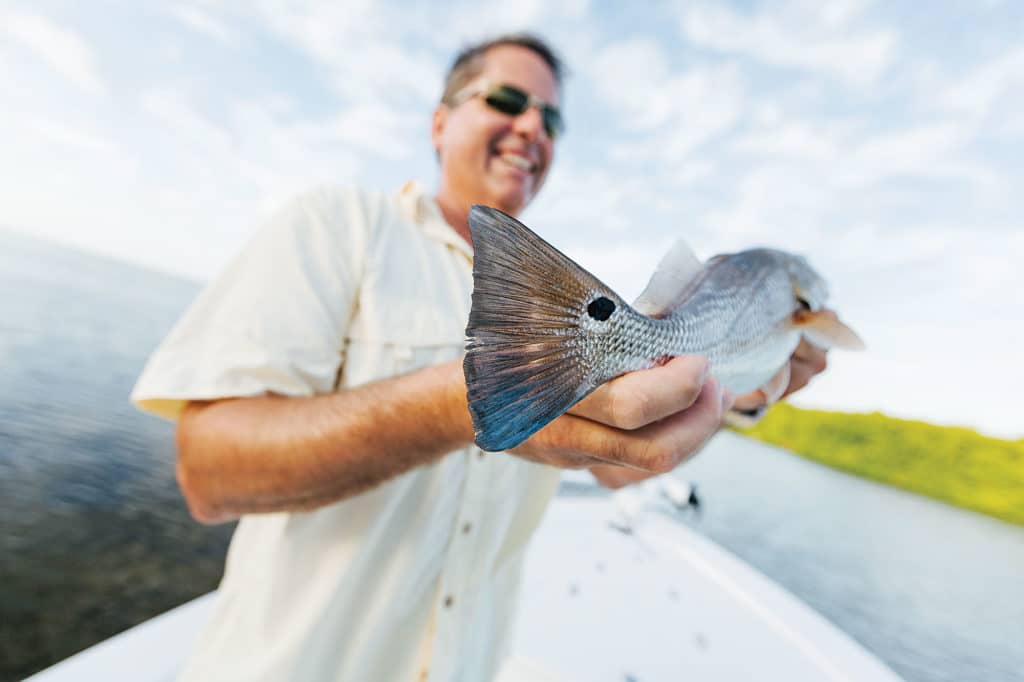
Guerrilla Tactics Once the word spreads about the action under the birds, it’s guaranteed to put plenty of boats on the water. It’ll be chaos at times. When a flock of birds is spotted, it often becomes a boat race to see who gets there first. If other boats are on a big flock of gulls, it’s OK to move in, but with the trolling motor so you won’t spook the fish.
Read Next: Watch the Birds
Some days the fishing can be crazy—a fish hooked on just about every cast. It’s definitely all right to catch-and-release reds and trout all day long. In fact, during September it’s not unusual to catch 25 or 30 undersize trout in a few hours of run-and-gun fishing. Be sure to handle and unhook undersize fish with care, and don’t ice too many keepers during the frenzy. This is a time when game wardens are not in the habit of writing warning tickets.
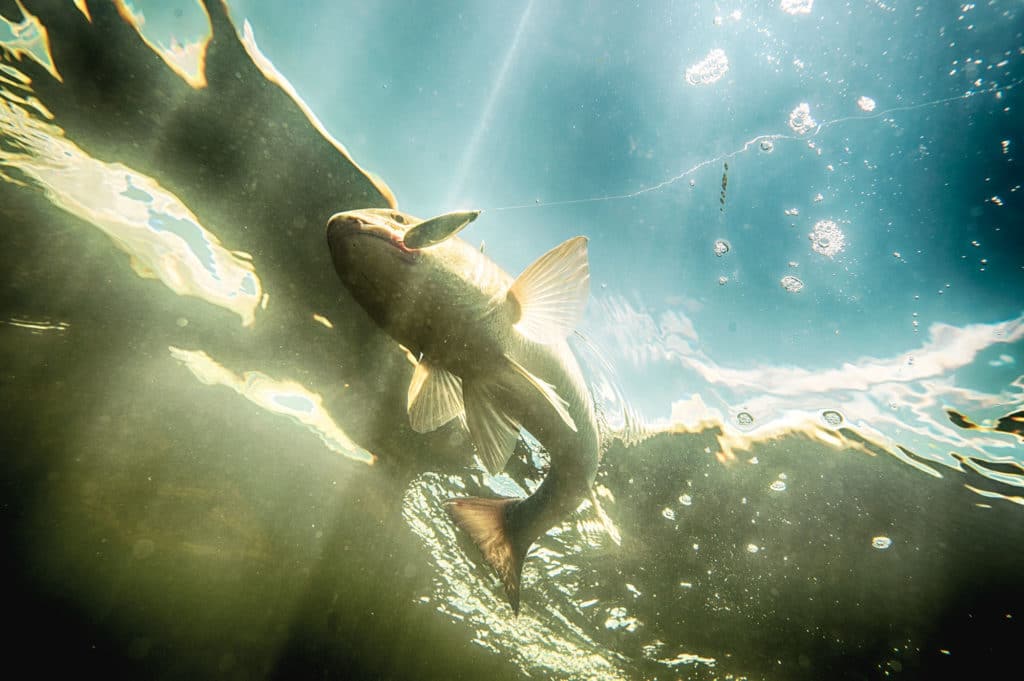
SWS Planner – Gulf Inshore Fish Feeding Under Birds
What: Speckled trout and redfish Where: Texas and Louisiana inshore waters, including Calcasieu and Sabine lakes, and Galveston and Matagorda bays When: September through November, when the fall shrimp and shad migrations occur Who: The following guides will put you on fish and show you how it’s done:
Sabine Lake Capt. Jerry Norris 409-718-8782
Galveston Bay Capt. Jim West 409-996-3054
Matagorda Bay Capt. Charlie Paradoski 713-725-2401
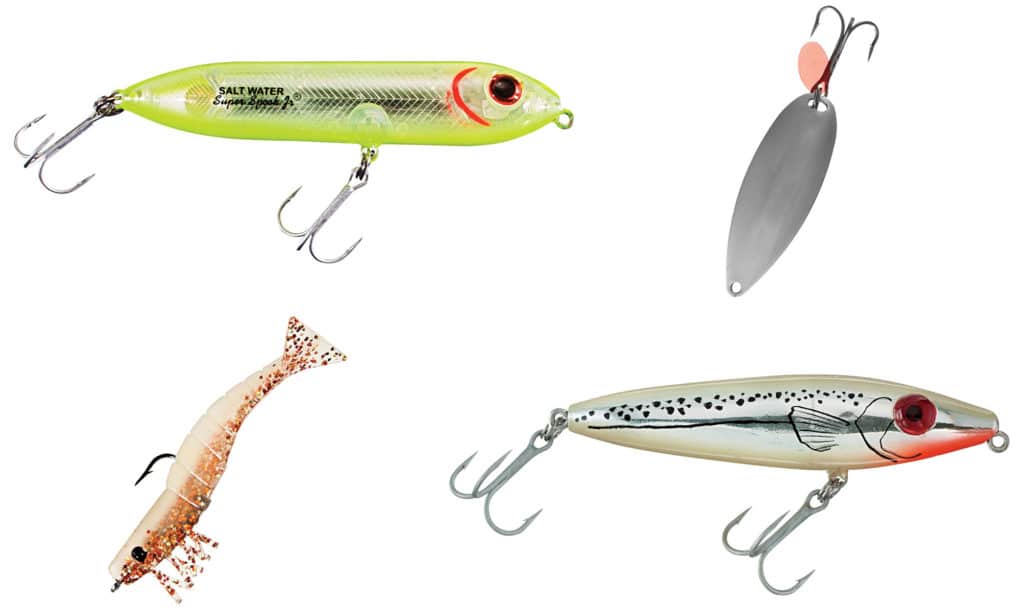
Johnson Sprite (top right): Fish foraging on baitfish find this spoon’s flash and wobble irresistible.
D.O.A. Shrimp (bottom left): This classic soft plastic is a must-have when fishing under birds.
Mirrolure She Dog (bottom right): Twin rattles inside ring the dinner bell. Courtesy Manufacturers
Tackle Box – Gulf Inshore Fish Feeding Under Birds
Rods: 6- to 6 1⁄2-foot for 10- to 20-pound line Reels: Spinning or baitcasting with a fast (about 7.1:1) retrieve ratio Line: 20-pound braid with a 4-foot section of 15-pound fluorocarbon leader Lures: D.O.A. shrimp and C.A.L. series shad tail, MirrOlure Top Dog and She Dog, Heddon Saltwater Super Spook and Spook Jr., 1⁄2-ounce silver spoon









